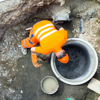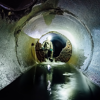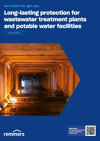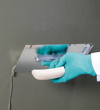Wastewater treatment

Long-lasting protection for wastewater and drinking water facilities
Long-lasting protection is a vital requirement for sewage treatment plants. Wastewater leaks from treatment plants or pipelines must be prevented. Otherwise, there may be a risk to human health and the environment. It is therefore essential to ensure long-term protection of sewage treatment plants, even under the most extreme conditions.
Municipal drainage systems and wastewater treatment plants
Germany’s sewer system began to be constructed more than 130 years ago. According to the Federal Statistical Office, public sewers in Germany stretch over a length of around 600,000 kilometres. Every day, an average of 127 litres of wastewater per person is discharged into these sewers from kitchens, bathrooms and utility rooms. The current figures lead to an annual wastewater load of approx. 5 billion cubic metres; this contains a wide range of substances that can attack building materials in different ways. Sulphuric acid and methane gases are among the most chemically aggressive substances. Salts such as nitrates, sulphates and chlorides, as well as pH values < 4.5 also attack the structures inside the sewers. In addition, roots can pierce and block the sewer tunnels, while rats will use every crack in the walls to build their nests. According to official demographic reports, water consumption is expected to decline across large areas of Germany in the coming decade. Although this has a positive effect on the drinking water resource, the negative impact on maintenance costs for drainage systems is twice as large. Increased deposits and longer flow times are already leading to dramatically increased sulphide loads and consequently to an increased need for remediation within shorter time frames in wastewater treatment plants.

Standards in sewer construction
Drainage systems and structures that come into contact with wastewater are subject to particularly high corrosion resistance requirements. In order to achieve an acceptable service life for sewer structures, special requirements are therefore placed on the building materials and mortar used. The requirements and test methods required for mortar are regulated by DIN 19573, which was introduced in March 2016. It applies to all mortars for the construction and renovation of sewers and pipes, structures in municipal drainage systems and sewage treatment plants. Concrete for in-situ concrete structures, prefabricated concrete structures, prefabricated parts of buildings and engineering structures are excluded from the scope of application. Where available and also possible, existing European standards for the protection and repair of concrete structures and test methods were taken into account in DIN 19573.

Product and system requirements
-
Sewage plant and sewer construction
-
Exposure classes and limit values
-
Biogenic sulphuric acid in wastewater
-
Enormous economic damage
The safe route to professional restoration
Due to the large number of causes of damage and damage profiles on concrete and masonry structures, a distinction has been made for many years between the different approaches used when carrying out repairs. As a specialist in the protection and repair of mineral building materials, Remmers has been successfully analysing damage to structures for water and wastewater technology for decades. The damage to the building project is expertly analysed by taking material samples with a depth profile and evaluating them using the latest technology. The complex interplay of chemical and mechanical attacks and the associated deep damage to the structure is given particular focus. Well-founded specialist knowledge in the assessment of damaged building elements along with the continuous refinement and optimisation of product properties guarantee product compatibility and functionality as well as maximum durability and stability. One of the key requirements for products and systems for use in wastewater treatment plants is resistance to chemical attack. The performance – and thus the resistance to chemical attack – of mortar products for drainage systems must be verified in accordance with the specifications of DIN 19573.

Advantages and properties of Betofix XWW4
Protection against biogenic sulphuric acid corrosion
Maximum protection against biogenic sulphuric acid corrosion
Resistant to chemicals
Long-lasting chemical resistance to acids and alkalis
Durable
Can be used up to the highest exposure class XWW4
Long-lasting
High mechanical resistance
Damage and repair
1. Manhole head restoration (manhole cover & manhole frame)
- Restoring operational safety
- Repair of localised areas
- Restoring stability
2. Installation parts / step iron restoration
- Restoring operational safety and leak-tightness
- Assembling installation parts
3. Repair / concrete replacement
- Repair and reprofiling of broken-out areas and defects
- Structural strengthening
- Reinforcement of concrete structures
4. Mineral waterproofing slurries
- Protection against attacks from wastewater
- Waterproofing against groundwater
- Increasing the abrasion resistance
5. Coating
- Protection against attacks from wastewater
- Waterproofing against pressing groundwater
- Restoring the wear layer/stability
- Restoring or improving the static load-bearing capacity
- Restoring or improving the abrasion resistance
- Increasing the corrosion resistance

6. Wall and joint mortar
- Production and repair of masonry and joints
- Durable bond between tunnel clinker brick and masonry
- Compensation of compressive forces and unevenness between components
- Production of temporary water barriers
- Closing of hollow coves, defects and cracks, and incorporating side inlets
7. Bedding mortar
- Laying ceramic coverings and linings
- Application with the thin-bed and thick-bed method
8. Penetrations and pipe connections
- Gas-impermeable connection sealing
- Also for water loads from the rear
- Restoring operational safety, leak-tightness and corrosion protection
9. Injection mortar
- Sealing water inlets and side inlets
- Filling cavities and cracks with an adhesionally coupled bond
- Filling annular gaps
- Filling voids
10. Injection resins
- Crack injection
- Waterproofing
- Joint sealing
- Bonding and casting of components

Sewers and drainage shafts
Concrete components in contact with the ground in water and wastewater construction, such as sewers, manholes, etc., are subject to permanent loads, e.g.:
- Chemical attack
- Biological attack
- Mechanical loads (abrasion)
- Dynamic loads (traffic)
- Positive and negative water loads
Remmers product systems are optimised for these requirements. The requirements for the most frequently used products are defined in DIN 19573. A key feature of this product standard is the classification of products into chemical exposure classes (XWW1 - XWW4). Our product systems, insofar as they fall within the scope of this standard, have been tested in accordance with these criteria without exception.
Sewage treatment plants
The individuality of wastewater disposal structures in terms of supporting structure, construction process and effects over the service life of the component creates repair situations that are too complex for standard solutions. Environmental, emission and odour protection standards require universally resistant protection systems, especially in view of the wide variety of designs and application technologies used in wastewater systems. Chemical resistance and divergent temperature situations in turn stress the contact surfaces.
These extreme and widely varying loads not only require concrete replacement that is certified in accordance with DIN 19573, but also surface protection, which is described in the exposure classes from XWW1 to XWW4. The combination of Betofix R4 SR as a concrete replacement mortar and Betofix XWW4 or Epoxy Universal as surface protection can withstand almost any attack and enable the planner to realise particularly demanding projects with the necessary security in planning and execution. We recommend applying additional surface protection systems to the outside of the structure.
Fermenters
The efficiency of sustainably producing heat and electricity systems can only be ensured through undisturbed operation over long production periods. As biochemical degradation reactions take place inside these environmentally friendly systems, which originate from decomposition products from organic compounds, there is inevitably damage to the unprotected concrete surfaces. Especially in the upper area, the gas chamber, acids and gases form which can lead to corrosion of the reinforcing elements and concrete, and thus restrict or even prevent operation after a short production period.The life cycle and efficiency of the described systems therefore depend directly on the protection of the tanks against these aggressive substances. Protection systems in accordance with exposure class XWW4 are required for the protection of new structures or the renovation of existing facilities in order to ensure long-term use.
Remmers offers two different systems for this:
Mineral bonded – Betofix XWW4
Synthetic resin bonded – Epoxy Universal
Drinking water tanks
The surface structure of concrete is characterised by cavities and roughness, meaning that even tiny particles adhere to it easily. Over time, this leads tohygiene problems in the form of deposits. The cleaning processes required to remedy this are particularly labour-intensive and time-consuming. Our slurry technology makes it possible to produce thin-layer protection and waterproofing systems.
With Betofix R4 SR, levelling and protection systems can even be implemented in a single process (even thick layers) under ideal conditions. From crack repair, general repair and levelling to sealing and coating, our systems can be applied both manually and mechanically. In addition to guaranteed durability, our focus is on creating an easy-to-clean surface.
Maximum protection against biogenic sulphuric acid
-
Betofix XWW4
-
Epoxy Universal
Joint solutions in detail
Structural joints are unavoidable when constructingindustrial facilities. Construction joints are required in orderto plan and execute logical work sequences. Movementjoints prevent forced stresses in the structureand reduce the formation of cracks in components.In wastewater treatment plants, the materials usedmust not only have waterproofing and crack-bridging properties, but also meet high requirements in terms ofchemical resistance. Remmers products have been proving their effectiveness in this domain for many years.
Peace of mind guaranteed
Benefit from our expert advice, our promise of optimum safety for our extensive product range, and our express delivery service.
Express delivery
Our express delivery is the ideal service for anyone who needs their order to be delivered fast.
Specialist representatives directly on site
Our specialist representatives are on hand to provide you with personalised support and advice – wherever you are.
Extensive product range
From building and floor protection products through to wood preservatives, we have everything you need!
Systems with Remmers guarantee
You can be sure of a reliable and high-quality solution for every application.
Segment brochure – Wastewater treatment




















